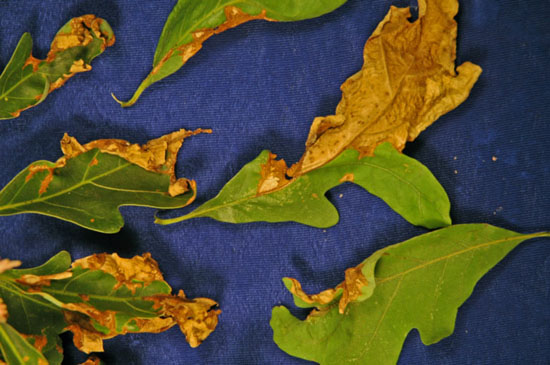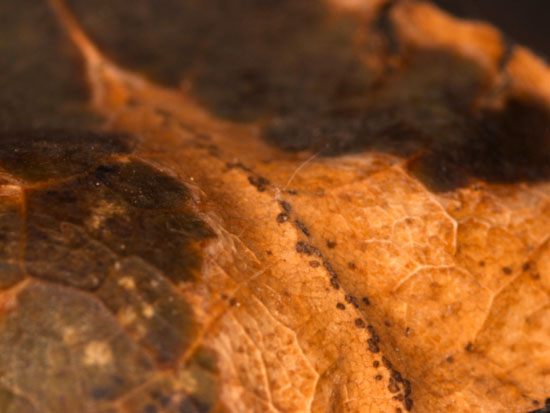Issue 6, May 29, 2012
Oak Anthracnose
After an abnormally warm, dry spring in Illinois, anthracnose might still be rearing its head. Anthracnose is a disease caused by a variety of fungi, all morphologically similar and with similar symptoms: tan to brown or black lesions on the leaves, stems, flowers, and fruits of various plants. Anthracnose infections occur during rainy, spring weather, and usually subside by mid-summer. Oaks are specifically infected by a form of Discula anthracnose, Discula quercinia. Over 20 species of oak are prone to varying degrees of infection. White oak (Quercus alba) is a highly susceptible species.

Anthracnose on oak leaves
Fungal spores of Discula quercina are present on the tree year round, inhabiting the buds, twigs and leaves. The infection process is initiated during wet conditions in spring as spores are splashed onto developing leaves. Ascospores, produced on fallen leaves, also contribute to new infections.
There are three main types of symptoms related to oak anthracnose: twig and leaf dieback, leaf distortion, and angular necrotic spots on the mature leaf. Symptoms are usually heaviest on the lower branches. Fungal fruiting structures can be observed on leaves when viewed under a magnifying lens or microscope. The fungus also produces ascervuli, which look like brown to orange pustules on the twigs. The leaf infections continue along the leaf veins into the twigs. The fungus can be actively producing conidia within 2 weeks after the initial infection. New conidia will contribute to further rounds of infection. If conditions are highly favorable and the trees are stressed beforehand, the infection may cause defoliation and twig dieback. Do not be alarmed by the defoliation. In most cases, the infection is not harmful to the long-term health of the tree. The oak can recover by producing new leaves to replace dead ones.

Magnified view of acervuli or fruiting structures of anthracnose on an oak leaf
There are several methods of control for oak anthracnose:
- Large trees can be pruned to improve air circulation. Improved air circulation will lessen the amount of time the foliage remains wet, thereby reducing the likelihood of infection.
- Sanitation can be helpful, especially on smaller trees. Removal of cankerous twigs to lower the spore numbers can reduce the infection rate. It is also recommended to remove infected plant debris during the winter so that primary inoculum is reduced during the spring.
- Proper watering and fertilization of the tree to reduce stress can make the tree less susceptible to infection in the upcoming spring.
- Fungicides are not usually recommended for anthracnose diseases. The damage caused by the disease is mostly aesthetic. Additionally, spraying a large tree with fungicides may be cost prohibitive. Specific chemical options are provided within Pest Management for the Home Landscape. Apply a suggested fungicide two or three times, at 14-day intervals, starting at leaf emergence. Thorough coverage is required. The manufacturer's directions should be carefully followed. Spraying after the disease is evident will only protect healthy new leaves.
It is common to mistake the symptoms of oak anthracnose with other Quercus (oak) disease. Below is a more comprehensible chart listing some of the disease that it might be confused with:
Disease / Pathogen | Symptoms |
|---|---|
Oak Anthracnose (Discula quercinia) | Defoliation, twig dieback, necrotic spots of leaf tissues. These symptoms usually appear in the lower section of leaves because it is most damp there. Symptoms appear during spring when conditions are wet. The host, however, can recover from the disease. |
Bacterial Leaf Scorch (Xylella fastidiosa) | Chlorosis and discoloration, stunted growth and scorching patterns of necrosis present on leaves. The symptoms start on the upper layer of leaves, but leaves continue to remain intact throughout the season. As the years pass, the infection can continue until finally the host is dead. |
Oak Wilt (Ceratocytis fagacearum) | Symptoms emerge around spring and summer. They first appear at the top of the tree. Symptoms include wilting, chlorosis along the veins of leaf tissue, leaf cast and discolorations in the xylem. Because the fungus attacks the vascular system, it can kill the host. |
For more information, visit: www.extension.umn.edu/distribution/cropsystems/M1288.html (Travis Cleveland and Zu Dienle Tan)
Authors:
Travis Cleveland
Zu Dienle Tan